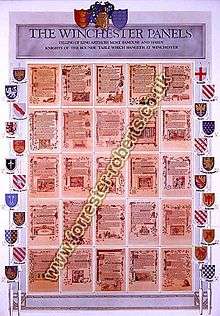Winchester Castle
| Winchester Castle | |
|---|---|
| Hampshire, England | |
|
The Great Hall, built by Henry III | |
 Winchester Castle | |
| Coordinates |
51°03′45″N 1°19′14″W / 51.06243°N 1.32054°WCoordinates: 51°03′45″N 1°19′14″W / 51.06243°N 1.32054°W grid reference SU476295 |
| Site information | |
| Owner | Hampshire County Council |
| Condition | Great Hall remains, used as museum |
| Site history | |
| Materials | Stone |
Winchester Castle is a medieval building in Hampshire, England. It was founded in 1067. Only the Great Hall still stands; it houses a museum of the history of Winchester.
Great Hall
Between 1222–1235, Henry III (who was born at Winchester Castle) added the Great Hall, built to a "double cube" design, measuring 110 ft by 55 ft by 55 ft (approx. 33.5m by 16.8m by 16.8m).[1] The Great Hall is built of flint with stone dressings; originally it had lower walls and a roof with dormer windows. In their place were added the tall two-light windows with early plate tracery. Extensions to the castle were made by Edward II. In 1873 the roof of the Great Hall was completely replaced.
An imitation Arthurian Round Table hangs in the Great Hall. The table was originally constructed in the 13th century, and repainted in its present form for Henry VIII; around the edge of the table are the names of King Arthur's knights.
Behind the Great Hall is a re-creation of a medieval garden called Queen Eleanor's Garden. A series of pictorial epigrams illuminated in medieval monastic style known as The Winchester Panels hang in the Great Hall. They depict the 25 knights of the Round Table and illustrate the challenges facing a maturing character as it progresses round the great "Wheel of Life".[2]
 The Great Hall
The Great Hall The "Winchester Round Table" in the Great Hall, Dendrochronology dating has placed it at 1275.
The "Winchester Round Table" in the Great Hall, Dendrochronology dating has placed it at 1275. Statue of Queen Victoria in the Great Hall
Statue of Queen Victoria in the Great Hall

History
In 1141, during The Anarchy, forces of the Empress Matilda were besieged by King Stephen at the castle.
In 1302, Edward I and his second wife, Margaret of France, narrowly escaped death when the royal apartments of the castle were destroyed by fire.
On 19 March 1330, Edmund of Woodstock, 1st Earl of Kent was beheaded outside the castle walls in the Despenser plot against King Edward III.
Margaret of York, daughter of King Edward IV, was born here on 10 April 1472.
On 17 November 1603 Sir Walter Raleigh went on trial for treason for his supposed part in the Main Plot in the converted Great Hall.
The castle was used by the Royalists in the English Civil War, eventually falling to Parliamentarians in 1646. Oliver Cromwell then ordered the castle's destruction.
In the 17th century, Charles II planned to build King's House adjoining the site, commissioning Christopher Wren to design a royal palace to rival the Palace of Versailles. The project was abandoned by James II
Another notorious trial took place in the Great Hall, on 15 March 1953; the 3rd Baron Montagu of Beaulieu Edward Montagu along with Michael Pitt-Rivers and Peter Wildeblood went on trial on charges of having committed specific acts of indecency.
The Castle today
Since 1889 Winchester Castle has been the seat of Hampshire County Council whose offices neighbour the Great Hall. Nearby, the excavated remains of the round tower with Sally ports and Guardrobes in the medieval city wall can also be seen.
Winchester Castle is also the name of a local football team.
See also
Sources
- ↑ "Winchester Castle". Retrieved 16 November 2014.
- ↑ Forrester-Roberts
External links
- The Great Hall and Round Table - official site
| Wikimedia Commons has media related to Winchester Great Hall. |
